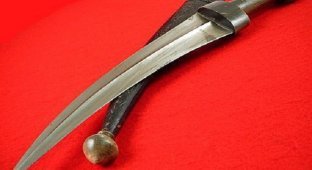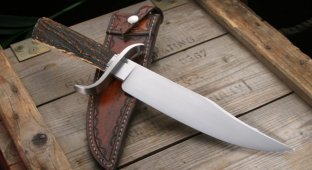How it was. Part 20. Knives and other “equipment”. (25 photos)
I present to you a small selection of armor and weapons. I warn the lazy people at once there are not just a lot of letters, but a lot. For aesthetes, I want to add - it has not been read or verified.

No matter how good the dagger was in battle, the soldier still needed a light blade for household and household needs, which could also be useful in battle. It is generally accepted that a knife is the most useful item a person can carry on a hike. Therefore, the warriors always carried a knife with a blade sharpened on one side. There are a great variety of such knives. And it is not possible to describe them all. Let's remember just a few.

For example, the traditional weapon of the Germans is “scramasax”, or simply “sax” (lat. scramasax, sax) - a knife that gave its name to an entire people and the most common combat knife in Europe. And almost the only combat knife among the Vikings. Scramasax was an auxiliary weapon. And they had a relatively short length for a bladed weapon - 35-55 cm (of which the handle accounted for about 10 cm). With this length, the width of the blade was from 2 to 3 cm, and its thickness at the handle was from 0.6 to 0.9 cm. With a weight of 0.6-0.7 kg.

The blades of the skramasaks were straight; only sometimes skramasaks are found with a sickle-shaped blade. But in any case, with one cutting edge, a wide spine and a sharp tip. The handles were usually curved and made of wood, horn or bone. And they could either consist of two cheeks mounted on rivets, or they could be solid, mounted on a shank. Sometimes skramasaks were equipped with sword-type handles and even equipped with guards. The large thickness of the blade made it possible not only to deliver powerful piercing blows, capable of piercing armor up to chain mail, but also to use the scramasax to parry enemy blows. This knife was also suitable for delivering chopping blows. The Scramasax scabbards were made of leather and richly decorated with ornamented overlays. Using several straps or a series of rings, the skramasax was suspended horizontally from the belt, and the arrangement of the ornament on the scabbard implies that it hung on the left side.

Scramassaxes also came to Rus'. Where such knives were found during excavations in Novgorod, Pskov and Smolensk. One of these found knives has a length of 37.5 cm, a width of 2.4 cm, and the length of its blade is 25 cm. Another has, with the same blade width, a length of 51 cm, of which the blade accounts for 42 cm.
Such weapons perfectly protected its owner from both people and animals. They could not only kill an animal, but also skin it, dismember game, or even cut down a tree. Judging by archaeological finds, in Europe the Scramasaxes were used as a “democratic” type of weapon. Characteristic mainly of non-noble layers of the population.

In addition to the skramasaks, the cleaver, a cutting-and-piercing combat knife of especially large sizes (64 - 72 cm), became widespread in Europe. The cleaver blade could be either straight or curved, double-edged or single-edged. Its length was usually 64-72 cm, and its width was 4-5 cm. The cleaver, as a rule, had a hilt. Initially, the cleaver was a shortened sword with a wider blade, slightly curved at the end. This version is supported by the fact that the handle of the cleaver was cast from copper along with the cup and bow of the guard, like a sword. The cleaver has been in service with the Russian army since the 18th century, having been borrowed from Europe. In Russia, cutlasses were worn by infantry, artillery and engineering troops. But such a short weapon was poor protection against cavalry, and it weighed quite a lot, so from the end of the 19th century, in Russia, they were left only to drummers and musicians, as well as guard soldiers for use in peacetime.

And perhaps it’s worth mentioning the knife, which has become a legend in Russia. This is a Finnish knife or finka - a special type of knife that became widespread in the Russian Empire and the Soviet Union, a kind of “Russian-Finnish” phenomenon. In reality, he has a very indirect relationship with the Finns.

The Grand Duchy of Finland was part of the Russian Empire from 1809 to 1917. Before this, the territory of Finland belonged to Sweden. Both of these countries consistently pursued a policy of disarmament of the indigenous people, so as not to embarrass them with the presence of weapons and not to tempt them into joining the struggle for independence. Obviously, this state of affairs did not suit the Finns too much, which resulted in a movement, personified by the Finnish knife culture. The attitude towards its bearers - the daring knife fighters who controlled the villages - was, to say the least, ambiguous even in Finland itself. These were a kind of fighters for freedom and independence on the one hand and dashing robbers on the other. Their distinctive feature was the inlaid handles of their puukko knives. Other Finns also carried traditional, functional, inexpensive and convenient knives. The total length of a Finnish knife, as a rule, did not exceed the width of two palms of the owner. It is safe to say that the Finnish puukko is both a universal tool for performing household work and a civilian weapon. And in one blade. And let me remind you that they were produced en masse in Finland, which was part of the Russian Empire.


As a result, until 1917, the northwestern part of Russia, inhabited by Russian and Finno-Ugric peoples and having close contacts with the Finnish autonomy, actively used Finnish knives. Favorably differed from others in terms of price-quality ratio. And not only as a multifunctional tool, but also as a means for the marginalized. Lev Lurie, in his work dedicated to the St. Petersburg outcasts, pointed to a Finnish knife and a weight, which acts as a brass knuckle, as an indispensable attribute of their equipment. Apparently, the hooligans were not stupid people and preferred “knives for household purposes” to more criminal daggers. At the same time, we should not forget that St. Petersburg in the 19th - early 20th centuries was the capital of the empire, in whose stores the best knives from all over the world were presented - from Central Asia and the Caucasus, Zlatoust and the Nizhny Novgorod province, Solingen, Sheffield, Nogent and San Francisco. But as a civilian weapon, it was the Finnish-made knife that was popular.

The use of classic puukko by the Finnish army during the Second World War proved to be very effective. The memories of the participants in those battles are replete with stories about Finnish night silent knife attacks, and skilled knife throwers capable of cutting the throat of a patrolman from ten meters away. Which, however, has always been denied by the Finns. But the effectiveness of this weapon is evidenced by the fact that the puukko was a coveted trophy for a Red Army soldier. However, it should be noted that the use of puukko as a weapon was not its main purpose. It was precisely a universal tool that helped a soldier in carrying out a combat mission: camouflage on the ground, equipping a combat position, organizing traps, repairing equipment, making drags, stretchers, snowshoes, means of immobilization for wounds, equipment of overnight accommodation, cooking, etc. Its necessity was obvious to Soviet military leaders.

One-piece finches in gift form with dedicatory inscriptions were used to reward distinguished soldiers and military leaders. Knives were also produced in a handicraft way. And it was during the war years that a special type of late Russian Finnish woman with its characteristic features was finally formed. Going back to classic Russian boot knives. So, already in 1940, a scout knife was adopted for service, and later the airborne troops received a knife with a plastic sheath and the handle of a “scout knife” HP-40. Which, in fact, is one of the varieties of the Russian Finnish with a beveled butt and an S-shaped guard. Unlike the puukko, it had a narrow and long blade (the ratio to the length of the handle was 1.5 - 2.2, and not 0.8 - 1) and a powerful bevel of the butt (“pike”). Sometimes the “predatory” nature of the bevel was emphasized by a slight bend of the butt in the direction opposite to the blade.

The popularity of the knife among the troops, the mass production of varieties and replicas of the “scout knife” by factory and artisanal methods led to the consolidation of its design and shape in the domestic knife tradition. These knives did not at all resemble puukko, but according to the rooted tradition in Russia, finks were the name given to everything that had a straight blade with a one-sided or one-and-a-half sharpening, a bevel of the butt and the inevitable, deep valleys, colloquially called krovostok. Finks of that time had powerful pommels, prominent handle bellies, front lugs, and even developed stops. Very popular on the blade were symmetrical fullers and a significant (up to 2 cm) threshold - an unsharpened area between the blade and the handle, also not typical of puukko.
The execution of the handle deserves special mention. The simplest models had a solid wooden, plastic or textolite handle mounted on a shank with a seal on the head. Less common was plate mounting with cheeks riveted to a wide shank. The most popular were multi-colored inlaid handles made of aviation celluloid, organic glass, textolite and getinax. Aircraft aluminum and brass could be used on the head and other parts of the handle. The sheath is leather with a side seam (on the blade side) with a leather strap for wearing on a waist belt. Often the knife was worn behind the top of a boot.

And all this was not typical for puukko. Where it was considered especially chic to carry a knife on a pocket button. Also, on many Finnish rifles an element alien to the prototype appears - in the form of a developed crosshair on the guard.
But be that as it may, the popularity of knives made in Finland that existed at one time led to the fact that almost any knife with a straight blade and a beveled spine (“pike”) began to be called Finnish in Russia, regardless of the place of manufacture. And not at all like a puukko.



A Nepalese knife, just a knife and not a dagger (sharpened on only one side), the kukri attracts attention with the large reverse curve of the blade. This seems strange: the bend is too great and it is difficult to “catch” the enemy with the concave part. The kukri is also inconvenient for stabbing. Fencing and parrying blows with such weapons is also very difficult. But a blade of this shape, and even with a variable sharpening angle, gives maximum efficiency in chopping and cutting. The kukri blade has a characteristic “falcon wing” profile, sharpening along a concave edge and zone hardening. At the butt of the blade, the blade is much softer than at the edge of the blade. Kukri is characterized by hardness values of 25-27 HRC at the butt, 46-48 HRC in the middle of the blade and 55-57 HRC at the edge of the blade, or 57-58 HRC at the butt and about 60 HRC at the edge of the blade. Otherwise, breaking off the blade at the handle, and this area of the blade bears the maximum load during a chopping blow, is inevitable.

Kukri is believed to come from the Greek kopis, which has a similar curve, and came to Nepal with the army of Alexander the Great in the 4th century BC. e. But regardless of the source of origin, khukri is one of the most ancient types of bladed weapons that has survived to this day without major changes.

A special category of “exotic” weapons are blades that suspiciously resemble household equipment. Combat sickles, scythes, pitchforks, whips, threshing hammers, rakes... The similarity is by no means accidental. We are talking rather not so much about exotic weapons, but about the exotic combat use of objects in battle that were not intended for this at all. And, naturally, about the exotic circumstances that forced the warriors to develop such skills and attack the enemy with sickles or even rakes at the ready.
In Japan, where the lion's share of “improvised” weapons comes from, such a circumstance was “sword hunting” - “katanagari”. At the end of a protracted period of civil wars, Japanese rulers decided to disarm the population and prohibited peasants from keeping weapons. It wasn't the ban that was unusual. Similar laws existed almost everywhere. The peasants themselves were unusual. At this very time in Japan, many samurai - fighters of clans that lost in the war - were “demoted” to serfs. It was for their swords that the shoguns started hunting. As a result, the weapons were taken away from the soldiers. Instead of swords, they were given soil rippers - sais and sickles - kama. Please do not confuse with Caucasian daggers. Daggers are offended.
Sai.

Kama Japanese.

Kama Caucasian.

Sickles were also used as weapons (for lack of a better one) in Europe. But such a weak weapon is effective only in the hands of a master. European peasants were not craftsmen and considered scythes mounted upright on a shaft to be more effective. Sometimes the kama was equipped with a short spear shaft and held with two hands. But more often the total length of the combat sickle was only about 75 centimeters, of which 45 centimeters were on the handle. Often kama could be equipped with round Japanese guards.
The disadvantages of kama in fencing are quite obvious. This weapon is unsuitable for piercing attacks, and when parrying, the handle could easily be cut off. Nevertheless, the combat sickle provided interesting possibilities. The Kama was a very light, and therefore “fast” weapon. The “high” balance contributed to the efficiency of the cutting blow, and the high penetration ability of the narrow tip oriented across the handle compensated for the lack of weight. And even if it was not possible to penetrate the armor (kamas were forged, of course, from ordinary “household” iron), one could try to throw the enemy off balance by using the sickle like a hook.

But perhaps the most mysterious weapon is the gunsen, the samurai's fighting fans. Which became widespread after someone in Japan managed to stop the encroachments on his own life. They were not made from paper and bamboo, but from forged steel feathers, sharpened at the ends to resemble a razor, and were very expensive, but they were very weak weapons. In principle, it was possible to inflict shallow wounds with a fan, and by unfolding it, clamp the enemy blade. Masters, according to legend, created real miracles with gunsen, but it is very difficult to imagine a more ineffective design. The battle fan was also not a “secret” weapon, since only a completely blind person could confuse it with an ordinary fan. The gunsen owes its appearance to the custom of Japanese commanders giving orders by waving a fan rather than a staff. But military personnel don't like to carry non-functional items. With a wand, in extreme cases, you can at least repulse a blow. But with a fan... So the idea arose to forge fans from iron. As a left-hand weapon.




























